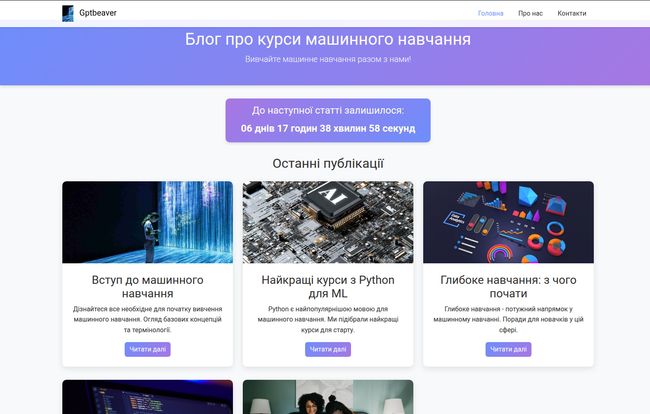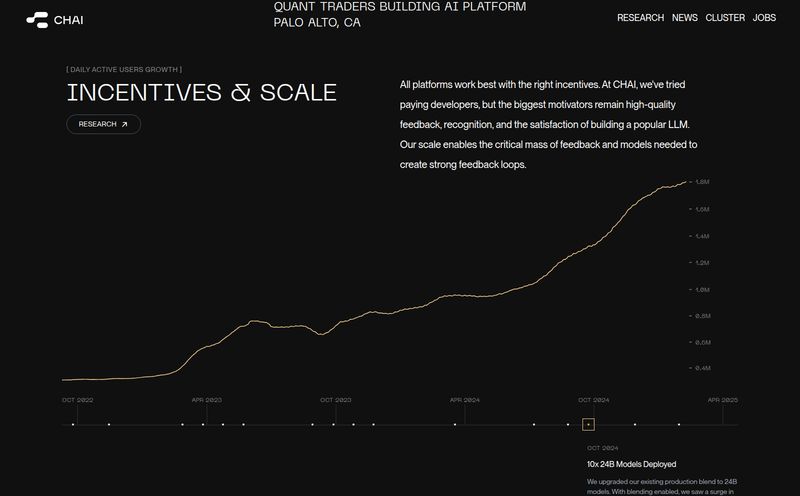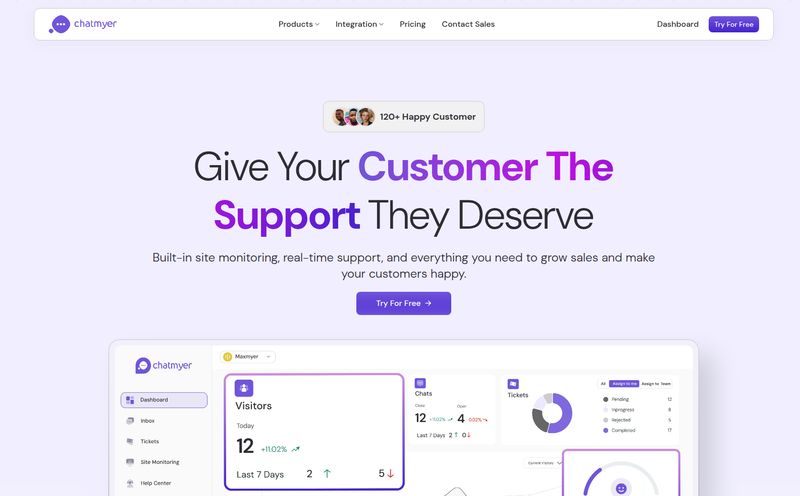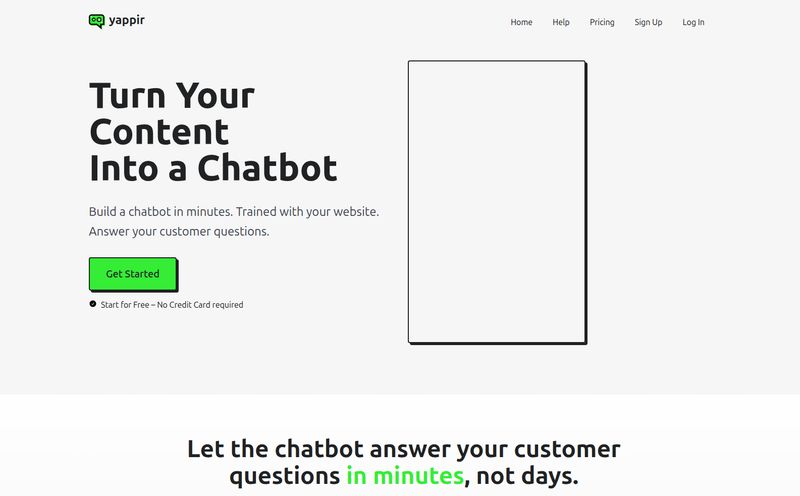My inbox, my social feeds, my entire digital life feels like a constant parade of new AI tools. Every single day, there's a new 'game-changer' that promises to write all my copy, design my graphics, and probably walk my dog. Most of them are... fine. Some are genuinely terrible. But every now and then, a little tool pops up that makes me lean in a little closer. One that feels less like a Swiss Army knife and more like a perfectly crafted screwdriver. Simple, single-purpose, and potentially very, very useful.
That's the vibe I got when I first heard about GPT Beaver.
Now, first things first. If you go searching for this, you might stumble upon gptbeaver.com, which is a pretty neat looking blog about machine learning courses, seemingly based out of Kharkiv, Ukraine. Cool site, but that's not the beaver we're building with today. We're talking about a different animal entirely: a tool that claims you can create your own custom ChatGPT microsite, powered by your own unique prompt, in seconds.
Seconds. That’s a bold claim. In a world where 'quick setup' can often mean a weekend of crying over API docs, 'seconds' gets my attention. But is it for real, or just another shiny object?
So What Exactly is GPT Beaver and How Does It Work?
Let's break it down without the marketing fluff. From what I can gather, GPT Beaver is essentially a clever 'wrapper' tool. It takes the raw power of a large language model, likely from OpenAI, and gives you a dead-simple way to build a little house for it. You provide the personality, the rules, the entire reason for being, and it spins up a standalone webpage with a chat interface.
Think of it like this: You can go to a restaurant and get a fantastic steak (that's ChatGPT). Or, you can use a service that takes that same quality of steak, cooks it exactly to your weirdly specific instructions ('I want it seared for 47 seconds per side and seasoned with Himalayan pink salt and exactly three peppercorns'), and serves it on your own personalized plate. That’s GPT Beaver. It’s not making the AI, it's giving your version of the AI a dedicated home.
The process sounds almost comically simple: you write a prompt, paste it in, and it generates the microsite. No code, no hosting configuration, no tears. Just an idea and a webpage.
The Magic Ingredient is Your Prompt
Here’s the thing that so many people miss about tools like this. GPT Beaver isn’t the magician. You are. Or, more specifically, your prompt is. The entire value of the microsite you create hinges on your ability to write a great prompt. This is where the art and science of prompt engineering comes in, a skill that's become ridiculously valuable over the last couple of years.
A weak prompt like "Be a helpful assistant" will give you a generic, boring chatbot. But a strong, layered prompt? That's where the fun starts.
Imagine creating a microsite for:
You are 'Captain Salty', a 17th-century pirate who has somehow learned about modern SEO. You give brutally honest, slightly insulting website feedback in pirate-speak. You refer to backlinks as 'allied ships' and keyword stuffing as 'flyin' too many flags'.
You are a 'Startup Idea De-risker'. You will listen to a user's business idea and ask five critical, Socratic questions designed to poke holes in their logic and expose potential flaws. Your tone is constructive but relentlessly realistic.
You are a 'RecipeBot 5000' that can only suggest recipes using five ingredients or less. You are pathologically afraid of complicated meals and will gently mock any user who asks for something fancy.
That's the power here. It’s not about just having a chatbot. It's about having your chatbot, with a personality and purpose that you've crafted. The tool is just the stage; your prompt is the star of the show.

Visit GPT Beaver
But this is also its biggest weakness. If your prompts are lazy, your custom chatbot will be, well, useless. It’s the classic ‘garbage in, garbage out’ principle, but on a very public stage.
Who is This Tool Actually For? Exploring Use Cases
My mind immediately started racing with ideas for who could get real value out of this. It’s not for every business, but for some, it could be a fantastic little arrow in the quiver.
For marketers and small business owners, this is a killer way to create an engaging piece of content or a unique lead magnet. Instead of another boring PDF ebook, why not offer a free, 15-minute consultation with an AI version of your brand's personality? It's memorable and way more interactive.
I could also see educators and coaches having a field day. Imagine a history teacher creating a chatbot where students can 'interview' Winston Churchill about WWII, or a life coach building a bot programmed with their specific framework to help clients with daily reflections. It's a specialized, on-demand assistant.
For my fellow developers and the more tech-savvy hobbyists, it's a prototyping dream. Got an idea for a complex chatbot? Spin up a quick version with GPT Beaver in five minutes to test the concept and the core prompt before you invest hundreds of hours building a full-stack application. It’s a proof-of-concept machine, plain and simple.
Let's Talk About The Good, The Bad, and The Hairy
Okay, let's get into the nitty-gritty. No tool is perfect, especially not in the fast-moving AI space.
On one hand, the sheer speed and simplicity are just undeniable. The idea of going from a funny idea in my head to a shareable, interactive webpage in less time than it takes to brew a pot of coffee is genuinely exciting. It lowers the barrier to entry to practically zero, which is great for creativity and experimentation.
It also makes the AI feel more tangible. There’s a psychological difference between chatting in a generic interface and interacting with a bot on its own dedicated page. It feels more official, more real.
However, I have some reservations. The information available is a bit... sparse. This feels a bit like a 'black box' service. What model is it running on? Is it GPT-3.5-Turbo? GPT-4? Is there a limit to how many messages you can send? Can you customize the look and feel beyond the prompt? These are important questions, and the lack of immediate answers makes the professional in me a little twitchy. It's a classic con of a new, rapidly developed tool; the documentation and feature lists often lag behind the core function.
And I have to say it again, it all comes back to the prompt. This tool doesn’t make you a great chatbot creator. It gives your prompts a home. The intellectual heavy lifting, the creativity, the actual work—that's all still on you.
What About the Price Tag?
This is the million-dollar question, isn't it? As of this writing, I couldn't find a clear pricing page. The information just isn't there, which can mean a few things. It could be in a free beta phase. It might be a free tool with limitations. Or they just haven’t figured it out yet.
If I were a betting man, I'd wager on a future freemium model. A free tier that lets you create a basic bot, maybe with a GPT Beaver branding and some usage caps. Then, paid tiers that unlock things like custom domains, more advanced models, analytics, and higher message limits. That's the standard playbook for this kind of SaaS tool, and for good reason. It lets people fall in love with the product before asking for their credit card.
The Bigger Picture: The Rise of AI "Wrapper" Tools
GPT Beaver is a perfect example of a trend I'm seeing everywhere: the explosion of 'wrapper' applications. Companies like OpenAI build the massive, complicated engines—the foundational models. Then, clever developers and entrepreneurs build user-friendly dashboards, interfaces, and specialized tools on top of them.
Some people in the tech community kind of look down on these tools, dismissing them as 'just API wrappers'. And you know what? They are. But that's missing the point entirely. Not everyone wants or needs to build a car from the ground up just to drive to the store. Squarespace is 'just a wrapper' for HTML/CSS, but it empowered millions of people to build websites. Canva is 'just a wrapper' for design principles, but it empowered millions to create graphics.
These tools are democratizers. They take incredibly complex technology and make it accessible. GPT Beaver fits right into that category. It’s taking the complexity of deploying a custom AI model and reducing it to a single text box. That’s not trivial; that’s smart.
Frequently Asked Questions about GPT Beaver
- Do I need to know how to code to use GPT Beaver?
- Absolutely not. That seems to be its main selling point. The only 'skill' you need is the ability to write a clear and creative prompt for your chatbot to follow.
- What kind of AI does GPT Beaver use?
- The specifics aren't entirely clear, but it's based on a 'ChatGPT' style model, which almost certainly means it's using one of OpenAI's GPT (Generative Pre-trained Transformer) models through their API.
- Is GPT Beaver free?
- Currently, there is no public pricing information. It may be free during a beta period or operate on a freemium model where basic features are free and advanced options are paid.
- How is this different from just using the regular ChatGPT website?
- The main difference is customization and presentation. With GPT Beaver, you create a dedicated, shareable microsite for a bot with a very specific personality and purpose that you define. It's for creating a unique AI experience, not just for general-purpose chatting.
- Can I embed my GPT Beaver chatbot on my own website?
- This is a key feature that isn't explicitly mentioned in the initial information. Ideally, a tool like this would offer an embed option. For now, it seems focused on creating standalone microsites, but embedding would be a logical next step.
- Is GPT Beaver the same as the gptbeaver.com machine learning blog?
- No, they appear to be two separate things that just happen to share a similar name. The tool creates chatbots; the blog teaches about machine learning.
So, Should You Bother with GPT Beaver?
Here’s my final take. GPT Beaver strikes me as a genuinely fascinating and potentially powerful little tool for a very specific audience. It’s not going to overhaul your entire business, but it could be an incredibly effective tool for a specific campaign, project, or just a fun experiment.
If you are a marketer, a creator, a teacher, or just an AI enthusiast who has a brilliant idea for a chatbot but not the time or skill to code it from scratch, then yes. You should absolutely bother. The barrier to entry is so low that the risk is virtually zero. At worst, you spend ten minutes and decide it's not for you. At best? You might just create the most interesting thing your audience has seen all year.
It's a testament to the current moment in AI—where a simple idea can be brought to life, not in months or weeks, but in a matter of seconds. And that, to me, is always worth a look.
Reference and Sources
- OpenAI: The likely provider of the underlying large language models.
- PromptingGuide.ai: An excellent, free resource for learning the fundamentals of prompt engineering.



